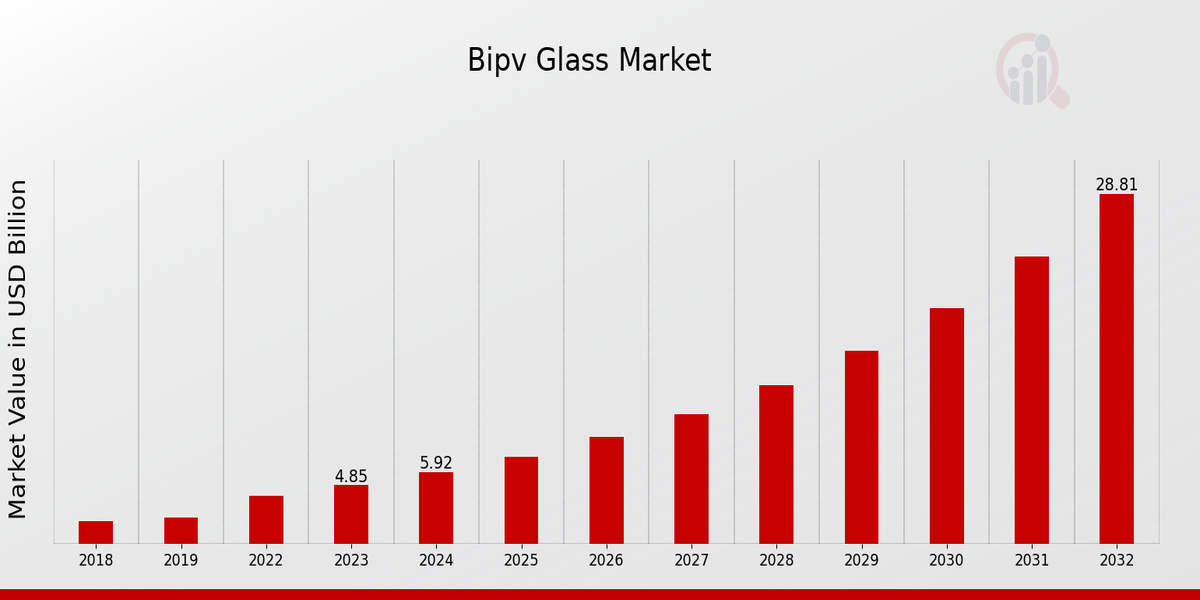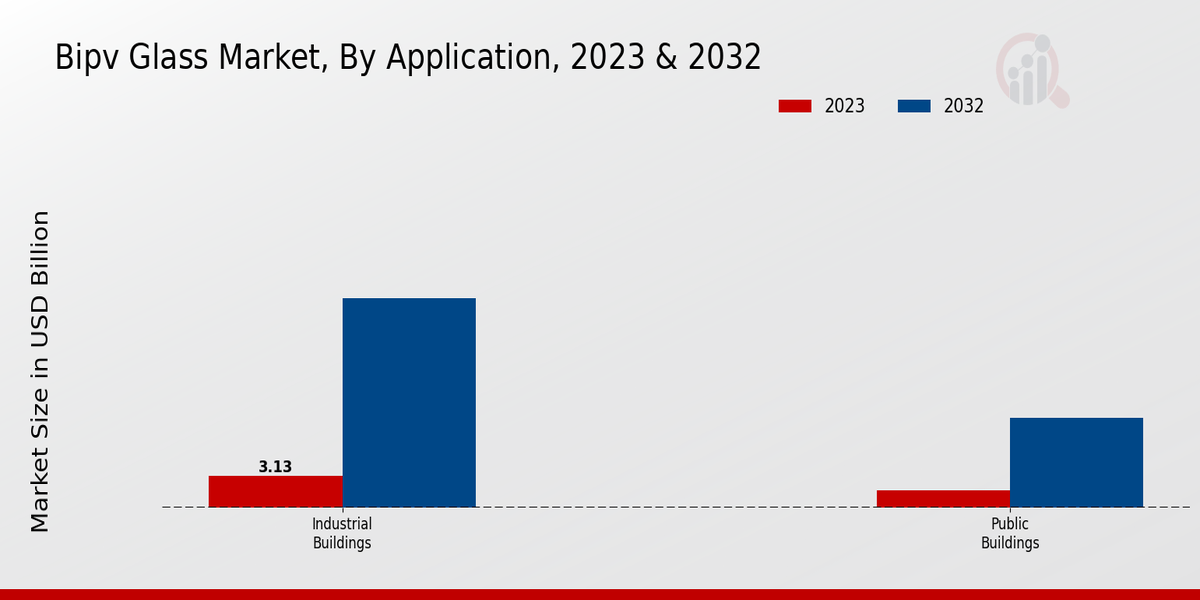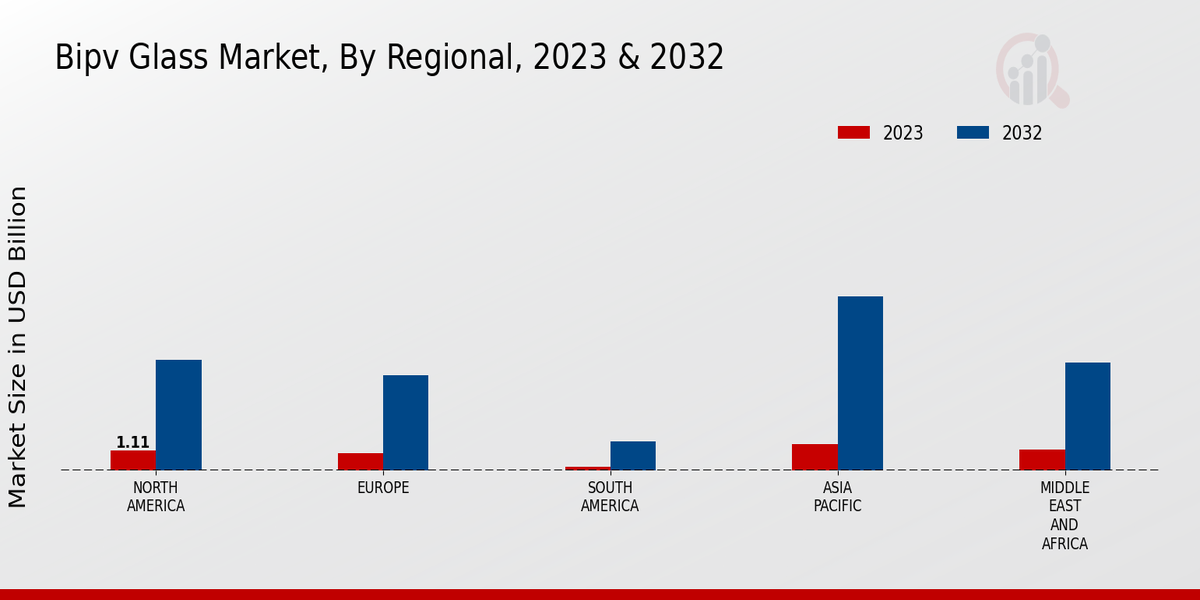Global Bipv Glass Market Overview
The Bipv Glass Market Size was estimated at 7.21 (USD Billion) in 2024. The Bipv Glass Industry is expected to grow from 8.78(USD Billion) in 2025 to 52.13 (USD Billion) by 2034. The Bipv Glass Market CAGR (growth rate) is expected to be around 21.9% during the forecast period (2025 - 2034).
Key Bipv Glass Market Trends Highlighted
Growing environmental concerns and the need for sustainable energy sources are driving the demand for BIPV glass, which combines photovoltaic cells with traditional glass to generate electricity from sunlight. Technological advancements in cell efficiency and improved aesthetics are further fueling market growth. Additionally, government incentives and regulations promoting renewable energy adoption are creating favorable market conditions.Opportunities exist in the integration of BIPV glass into various building types, including commercial, residentials and transportation. As the market matures, collaborations between glass manufacturers, building designers, and energy providers are expected to accelerate innovation and expand applications.
Recent trends include the development of transparent BIPV glass, allowing for natural light transmission while generating electricity, and the integration of energy storage systems to enhance grid stability. Moreover, the rising demand for smart cities and connected buildings is creating demand for BIPV glass with integrated sensors and monitoring systems.

Source: Primary Research, Secondary Research, Market Research Future Database and Analyst Review
Bipv Glass Market Drivers
-
Increasing Demand for Energy-Efficient Building Materials
The key factor driving the Bipv Glass Market is the increasing demand for energy-efficient building materials. Governments around the world have introduced strict policies regarding carbon emission control and increasing the energy efficiency of structures. To cope with these demands, BIPV glass manufacturers are providing products that combine both energy generation capabilities and unique architectural features. The growing adoption of green building construction materials and the rising popularity of net-zero energy buildings are only a few of the factors contributing to an increased demand for BIPV glass.
Technological Advancements and Cost Reductions
One of the key factors contributing to the growth of the BIPV glass market in the last decade is technological advancements, as they have allowed for both performance increases and cost downturns of BIPV products. Continuous research and development activities: improved the conversion efficiencies, enhanced durability and reduced the cost of manufacturing’, which has made this type of glass more popular than it was some twenty years ago.
Furthermore, the availability of high-efficiency BIPV glass at prices that are compatible with its non-energy-efficient counterparts has opened a great number of new opportunities for its use in different types of construction projects.
Government Incentives and Support
Government incentives and support measures have been instrumental in promoting the adoption of BIPV glass. Many countries offer tax credits, rebates, and other financial incentives to encourage businesses and homeowners to invest in energy-efficient technologies, including BIPV glass. These incentives have helped reduce the upfront costs associated with BIPV glass installation, making it a more viable option for many projects.
Bipv Glass Market Segment Insights
Bipv Glass Market Application Insights
The Bipv Glass Market is segmented by Application into Residential Buildings, Commercial Buildings, Industrial Buildings and Public Buildings. Residential Buildings: The residential buildings segment held the largest share of the Bipv Glass Market in 2023 and is expected to continue to dominate the market throughout the forecast period.
The growth of this segment can be attributed to the increasing demand for energy-efficient building solutions, government incentives for the adoption of renewable energy sources, and the rising popularity of BIPV glass in new construction and renovation projects.The Bipv Glass Market revenue for the residential buildings segment is projected to reach $12.5 billion by 2032, exhibiting a CAGR of 22.5% during the forecast period. Commercial Buildings: The commercial buildings segment is set to witness significant growth over the forecast period due to the increasing demand for BIPV glass in office buildings, retail stores, and other commercial structures.
The growing awareness of the benefits of BIPV glass, such as enhanced energy efficiency and reduced operating costs, is driving the adoption of this technology in the commercial sector.The Bipv Glass Market data for the commercial buildings segment is projected to reach $9.8 billion by 2032, registering a CAGR of 21.2% during the forecast period. Industrial Buildings: The industrial buildings segment is expected to witness steady growth over the forecast period.
The increasing demand for energy-efficient solutions and the need to cut down operating costs are driving the adoption of BIPV glass in industrial facilities, such as warehouses, factories and manufacturing plants. The Bipv Glass Market statistics for the industrial buildings segment are projected to reach $4.2 billion by 2032, exhibiting a CAGR of 19.5% during the forecast period. Public Buildings: The public buildings segment is set to grow at a relatively moderate pace over the forecast period.
The increasing focus on sustainability and the need to curtail energy consumption in public buildings, such as schools, hospitals and government offices, is driving the adoption of BIPV glass in this segment. The Bipv Glass Market industry for the public buildings segment is projected to reach $2.3 billion by 2032, posting a CAGR of 18.7% during the forecast period.

Source: Primary Research, Secondary Research, Market Research Future Database and Analyst Review
Bipv Glass Market Glass Type Insights
The Bipv Glass Market is segmented by Glass Type into Crystalline Silicon, Thin-Film Silicon, Perovskite Solar Cells and Compound Semiconductors. Crystalline Silicon holds the largest market share due to its high efficiency and durability. Thin-film silicon is expected to witness significant growth owing to its cost-effectiveness and flexibility. Perovskite Solar Cells are gaining traction due to their potential for low-cost, high-efficiency solar cells. Compound Semiconductors offer high efficiency and durability, making them suitable for various applications.In 2023, the Bipv Glass Market revenue was estimated at USD 4.85 billion.
The market growth is attributed to increasing demand for renewable energy sources, government incentives, and technological advancements.
Bipv Glass Market Installation Type Insights
The Bipv Glass Market is segmented by installation type into rooftop, facade, curtain wall and skylight. Among these, the rooftop segment is expected to hold the largest market share in 2023 and is projected to continue its dominance throughout the forecast period. The growth of this segment can be attributed to the increasing adoption of BIPV glass in residential and commercial buildings, as it offers a cost-effective way to generate renewable energy and reduce energy consumption.
The facade segment is expected to witness significant growth over the forecast period, owing to the rising demand for energy-efficient building envelopes.BIPV glass facades can help reduce heat gain and loss, thereby improving the overall energy efficiency of buildings. The curtain wall segment is also expected to grow at a steady pace, driven by the increasing popularity of glass curtain walls in high-rise buildings. The skylight segment is expected to grow at a moderate pace, as BIPV skylights can provide natural daylight and reduce the need for artificial lighting.
Overall, the Bipv Glass Market is expected to witness robust growth over the forecast period, driven by the increasing adoption of BIPV glass in various types of buildings.
Bipv Glass Market Performance Parameters Insights
The Performance Parameters segment of the Bipv Glass Market is categorized into Power Output, Efficiency, Durability and Aesthetics. Power Output measures the electrical power generated by the BIPV glass, typically expressed in watts per square meter (W/m). Efficiency refers to the conversion rate of sunlight into electricity, and higher efficiency leads to greater power generation. Durability encompasses factors such as weather resistance, mechanical strength and lifespan, ensuring long-term performance.
Aesthetics involves the visual appearance of the BIPV glass, including color, texture and transparency, enabling integration with building designs.These performance parameters play a crucial role in determining the overall market growth and industry dynamics of the Bipv Glass Market.
Bipv Glass Market Regional Insights
The Bipv Glass Market is segmented into North America, Europe, APAC, South America, and MEA. Among these regions, North America is expected to hold the largest market share in 2023, with a market value of 1.2 billion USD. Europe is expected to follow North America, with a market value of 1 billion USD in 2023. APAC is expected to be the fastest-growing region, with a CAGR of 23% from 2023 to 2032. This growth is attributed to the increasing adoption of BIPV glass in the construction industry in this region.
South America and MEA are expected to have a relatively smaller market share but are expected to grow at a significant rate during the forecast period.

Source: Primary Research, Secondary Research, Market Research Future Database and Analyst Review
Bipv Glass Market Key Players And Competitive Insights
The Bipv Glass Market is characterized by the presence of a few leading market players that have established a significant market share. These players have some of the most well-known brand names, wide distribution networks and product portfolios across different regions. Main competitors are investing heavily in innovation to stay at the forefront of market competition in the Bipv Glass Market and maintain their position. However, the industry remains highly competitive, with a large number of small and medium enterprises seeking market opportunities in specific market niches and regions.
Many of these companies are more agile and innovative and can respond more quickly to market trends and user requirements than their major competitors. In conclusion, such market competition leads to product differentiation, strategic business collaboration, and aggressive marketing within the market.One of the major competitors in the Bipv Glass Market is AGC Glass Co., Ltd., a Japanese manufacturer of high-quality glass and innovative glass solutions. AGC’s Bipv glass solutions are especially resilient and efficient, offer a high level of protection, and provide architectural features, offering a perfect fit for architects and end-users from different industries.
AGC has a large and extensive distribution network at the global level, meaning that the company has many opportunities for entering new markets and acquiring new customers. Additionally, the company’s commitment to sustainable development may improve its reputation in the market.Sanyo Glass Co., Ltd. is another major competitor in the Bipv Glass Market, offering innovative high-performance glass products. The company’s Bipv glass products are energy-efficient through their high light transmission, blocking solar heat, and high thermal insulation properties. Sanyo Glass is working on improving its market position, focusing primarily on the regions of Asia Pacific and some emerging markets.
The company is working on expanding its business internationally beyond the Asian market and other regions by acquiring other businesses. Additionally, Sanyo Glass invests heavily in research and development to discover new technologies.
Key Companies in the Bipv Glass Market Include
Bipv Glass Market Industry Developments
-
Q2 2024: Onyx Solar launches new range of colored photovoltaic glass for building integration Onyx Solar announced the launch of a new line of colored photovoltaic glass products designed for building-integrated applications, expanding its portfolio to offer enhanced architectural aesthetics alongside energy generation.
-
Q1 2024: Xinyi Solar achieves 9.6% YOY growth in solar glass business for sales volume in tonnes Xinyi Solar reported a significant year-over-year increase in its solar glass business, highlighting growing demand for photovoltaic glass products used in building-integrated photovoltaic (BIPV) applications.
-
Q1 2025: Masdar and Philippines sign $15 billion deal to supply up to 1 GW of sustainable energy by 2030 Masdar, the UAE state energy company, signed a $15 billion agreement with the Philippines to develop up to 1 GW of sustainable energy projects, which is expected to drive demand for solar PV glass, including BIPV glass, in the region.
Bipv Glass Market Segmentation Insights
-
Bipv Glass Market Application Outlook
-
Bipv Glass Market Glass Type Outlook
-
Bipv Glass Market Installation Type Outlook
-
Bipv Glass Market Performance Parameters Outlook
-
Bipv Glass Market Regional Outlook
| Report Attribute/Metric |
Details |
| Market Size 2024 |
7.21(USD Billion) |
| Market Size 2025 |
8.78(USD Billion) |
| Market Size 2034 |
52.13(USD Billion) |
| Compound Annual Growth Rate (CAGR) |
21.9% (2025 - 2034) |
| Report Coverage |
Revenue Forecast, Competitive Landscape, Growth Factors, and Trends |
| Base Year |
2024 |
| Market Forecast Period |
2025 - 2034 |
| Historical Data |
2020 - 2024 |
| Market Forecast Units |
USD Billion |
| Key Companies Profiled |
JA Solar, Bisol, Trina Solar, Canadian Solar, SolarFrontier, ReneSola, Hanwha Q Cell, First Solar, LG Solar, SunPower, Kyocera Solar, Panasonic, Astronergy, Jinko Solar |
| Segments Covered |
Application, Glass Type, Installation Type, Performance Parameters, Regional |
| Key Market Opportunities |
Growing demand for sustainable building materials Technological advancements in BIPV glass production Government incentives and regulations supporting renewable energy Increasing focus on energy efficiency in the construction sector Emerging applications in urban environments. |
| Key Market Dynamics |
Rising demand for sustainable energy sources, technological advancements, favorable government policies increasing awareness of energy efficiency growth in the construction sector |
| Countries Covered |
North America, Europe, APAC, South America, MEA |
Frequently Asked Questions (FAQ):
The Bipv Glass Market is projected to reach USD 7.21 billion in 2024.
The Bipv Glass Market is expected to grow at a CAGR of 21.9% from 2025 to 2034.
Asia Pacific is expected to hold the largest market share in the Bipv Glass Market in 2023.
The commercial segment is expected to account for the largest market share in the Bipv Glass Market in 2023.
Some of the key competitors in the Bipv Glass Market include AGC, Saint-Gobain, and Schott.
The key growth drivers of the Bipv Glass Market include increasing demand for renewable energy sources and government initiatives to promote green buildings.
The challenges faced by the Bipv Glass Market include high manufacturing costs and lack of awareness about the benefits of BIPV glass.
The opportunities for the Bipv Glass Market include growing demand for energy-efficient buildings and technological advancements in BIPV glass production.
The key trends in the Bipv Glass Market include the integration of BIPV glass with other building materials and the development of new BIPV glass technologies.
The Bipv Glass Market is expected to reach USD 21.9 billion by 2034.

















